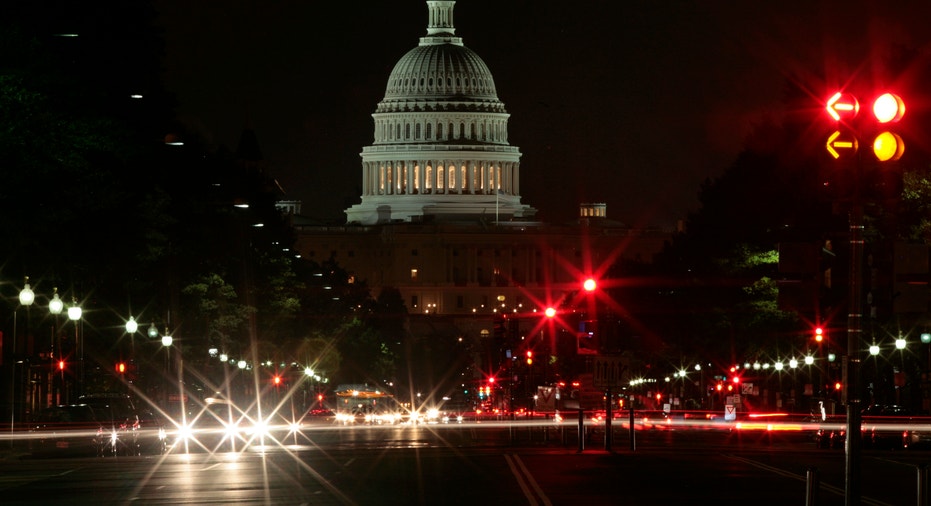Halfway There: Senate Passes Debt Ceiling Increase

In a vote of 81 to 18, the Senate on Wednesday evening passed a measure to re-open the partially shutdown government, and raise the debt ceiling, staving off a potential default after Thursday.
The deal, floated by the same body on Tuesday night, includes a continuing resolution to fund the government through Jan. 15, increase the nation’s borrowing limit through Feb. 7, continue to provide the Treasury Department with the ability to enact “extraordinary measures,” to pay America’s bills during future Congressional debt ceiling debates, and a provision for income verification for people who receive subsidies on the Affordable Care Act’s medical insurance exchanges.
The bill also includes instructions to assemble a bipartisan committee to gather and report by mid-December a way forward on the nation’s fiscal issues to avoid similar situations like the one lasting the last few weeks, in the future.
With the Senate’s blessing, the bill now heads from the Democratic-controlled body to the Republican-controlled House of Representatives for final approval before it lands on President Barack Obama’s desk for a signature.
Once the bill lands on the other side of the Capitol, it will move immediately go to the floor for a one-hour debate – skipping the House Rules Committee – and then move to a vote.
At this point, the legislation is expected to pass the chamber.
Earlier in the day, House Speaker John Boehner all but raised the white flag of defeat when he issued a statement saying the House would not block the Senate’s proposal from a vote on the floor.
“In addition to the risk of default, doing so would open the door for the Democratic majority in Washington to raise taxes again on the American people and undo the spending caps in the 2011 Budget Control Act without replacing them with better spending cuts,” he wrote.
Still, Boehner pledged to continue to stop the “train wreck that is the president’s health care law.”
Wall Street was Right
Though the nation was captivated by the goings-on at the Capitol for the last few weeks leading up to Thursday’s deadline – a time in which the Treasury Department said it would exhaust its extraordinary measures and rely on $30 billion in cash reserves to pay the nation’s bills – Wall Street took the tumult in stride.
Even after talks broke down and hope seemed all but lost on Tuesday afternoon and evening, U.S. stock-index futures rallied sharply, believing a deal was in sight. The U.S. equity markets followed suit Wednesday throughout the day, with every major index ending the day more than 1% higher, and every major sector washed in green.
Essentially, Wall Street said it wasn’t worried about the threat of default, and continued to believe, despite repeatedly failed attempts, that Congress would come to a resolution to resolve the government shutdown and avoid the potential default.
But really, all the legislation does at this point, Michael Block, chief strategist at Rhino Trading Partners said, is “kick the can down the road,” and package-up the fiscal fights to be re-opened early in the new year.
“It’s a bit perverse really,” he wrote in a note to clients Wednesday afternoon. “(Wall Street says,) ’Well, we are going to new highs because we are relieved that the government shutdown only lasted seventeen days and we somehow managed to avoid defaulting on our debt. This is so bullish.’ Someday we are going to look back on this and it won’t seem funny.”
Beyond Wall Street
The very public drawn-out debate over the borrowing limit and government funding weighed on more than just American sentiment and individual Wall Street traders.
IHS Global Insight Director of Federal Economics Paul Edelstein and Chief U.S. Economist Doug Handler told clients Wednesday the “win” from Congress really isn’t a win for the economy.
“With Treasury’s borrowing authority set to expire tomorrow, the US economy dodged a bullet today. But the reprieve will be short as lawmakers only agreed to a three month funding of the government and suspension of the debt ceiling. Democrats and Republicans remain far apart on fiscal policy and the stage is set for another showdown in January,” the pair wrote.
Further, IHS noted the U.S. economy is elastic enough to withstand, what it calls, a short-term episode like this fight, but a longer-term situation could cause Treasury to run out of borrowing authority, miss debt payments, and cause “catastrophic” results.
“Even if we avoid these scenarios, the US’s prestige in global financial markets and world capitals will continue to deteriorate if we lurch from crisis to crisis,” Edelstein and Handler warned.
In its Beige Book report Wednesday, the Federal Reserve said economic activity in September, and the start of October – the entire duration of the partial government shutdown -- grew at a “modest to moderate pace.”
“Contacts across Districts generally remained cautiously optimistic in their outlook for future economic activity, although many also noted an increase in uncertainty due largely to the federal government shutdown and debt ceiling debate,” the Fed said.
Digging into the central bank’s report, Deutsche Bank said the shutdown negatively impacted business confidence and job growth, which it says reflects a “slightly more cautious tone” than the Fed has taken in the past.
To that point, Standard and Poor’s in a press release Wednesday said it expects the shutdown to have cut about $24 billion out of the U.S economy.
“In the summer of 2011, as we approached the last debt ceiling standoff, consumer confidence plummeted and hit a 31-year low in August when the debt ceiling issue came to a head. Given that this round of debt-ceiling negotiations is occurring after two-plus weeks of a government shutdown, the total impact on the economy will likely be even more severe,” the ratings firm said.